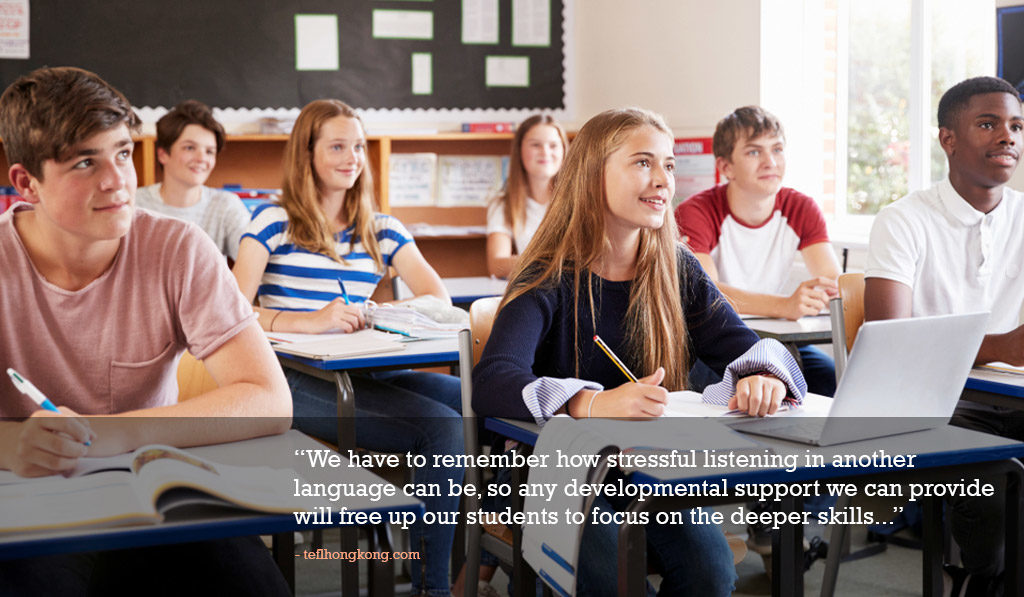
- By: Tom Garside
- In: For Teachers
Listening in a second language is so much more than simply understanding what someone is saying. We listen to different people in different ways depending on how, where and when we are interacting, or whether we are interacting at all.
In the field of ESOL, learners typically listen to three different sources of information in their lessons: the teacher, each other and, most commonly, an audio recording of one or two people speaking.
As teachers looking to develop the complicated range of communicative skills involved in listening, we have to consider several factors related to the message we are asking our students to listen to, the medium through which it is being delivered and the methodologies we can use to lead our students through this potentially daunting task.
Teacher Training Courses:
1. CertTESOL: Certificate in TESOL
A level 5, initial teacher training qualification for new and experienced teachers, equivalent to Cambridge CELTA.
2. CertPT: Certificate for Practising Techers
A level 6, online professional development course for working teachers.
Medium and Message
Think for a moment about an average week in your life – how many different people and sources of information do you listen to, and how many of these do you listen to consciously, or actively, where some kind of thought is required to decode or retain a message?
I would argue that most of the listening we do in our everyday lives is semi-conscious; we don’t really have to think about what we are listening to, as we are taking part in everyday situations such as talking with friends, interacting in formulaic service encounters (speaking with shop assistants, waiters, bank clerks, etc) or talking about familiar aspects of work.
This begs the question: why do we ask our students to think so carefully about the minute details of the listening recordings that we play for them?
Also, do we expect the same amount of attention from students as they interact with each other, or us as teachers? Do we see video tasks as a form of listening? Or work that we do in class with songs?
The medium (the way in which information is transmitted, as represented by these different listening situations) greatly affects how we perform listening activity – we listen to other people in a discussion quite differently to when we are taking notes for a specific task during a lecture or presentation.
For this reason, it is useful for students to develop different styles of listening for different tasks. This is something which can be highlighted to them through developmental listening activities in the classroom, and practised in our learners’ everyday lives (or for homework with different types of listening input).
Preparation, pre-teaching and task design
Bringing listening into the classroom, we have to remember that our learners are performing this work in a second language; this means that there is automatically more strain on their listening brains, more language work to be done, and often confidence issues in weaker listeners as the message flies past from the speakers.
These important considerations mean that we have to scaffold listening activity in most situations where students will be hearing something for the first time (unless they are in a test setting, in which case the test is how they deal with the lack of support).
Pre-listening stages are crucial to the development of good habits while listening activity takes place.Some ideas for pre-listening tasks are:
- Pre-teach any vocabulary that you predict will be new or particularly challenging for the learners in your group. Reducing vocabulary confusion, and the time that that takes away from other considerations about the message itself, will leave students with more headspace to focus on the task at hand.
- Make sure that your learners are familiarised with the people who they will hear, the setting in which they appear, and the genre of the audio recording (is it a news broadcast, a casual conversation or an argument? This will give students some context into which to set the recording when it starts.
- Set a clear task for students to perform before you hit ‘play’. This will give further expectations about the information they hear, and makes the listening that they undertake much more purposeful. If they know the type of information to listen out for, their performance during the task will be much higher, and confidence (a key aspect of listening in a second language) will be further raised.
Beyond comprehension
Most listening activity focuses on comprehension: recognising factual information from a speaker or speakers.
However, this may not fully prepare students to listen spontaneously to a range of different spoken media, or as an active participant in interaction in English. Go beyond facts and figures and ask more contextual questions about the setting, the speakers’ emotions and their reasons for saying certain things.
-‘What does the man tell the woman to do at the end of the conversation’ involves much shallower processing of information than
-‘Why was the woman surprised at the end of the conversation’ or
-‘Why did the man ask the woman the final question in their conversation?’.
Context-based questions can get learners engaged with deeper levels of meaning and interaction than simple comprehension enables.
Revitalising listening activities – don’t just press play
Finally, a point on the mechanics of playing listening tracks for students. Remember that an audio track is fleeting and transitory when played through from beginning to end, but is recorded, so does have some permanence for teaching purposes.
Think about times when it is appropriate to have students listen to a recording all the way through, getting what they can along the way, and when it might be better to play it in chunks, to build the information and give time for more processing of the message.
If you are aiming to develop broader listening skills in learners, playing the recording twice, with one listening for general, gist-level questions, followed by another listening with more detailed questions, is effective.
Do not be afraid to focus on specific sections of the recording to play again after the main task has been finished for key words or signposting language, asking staged questions along the way.
This is just the kind of support students need, and will lead to more informed comprehension than a single listen.
Conclusion:
Overall, we have to remember how stressful listening in another language can be, so any developmental support we can provide will free up our students to focus on the deeper skills that we all use without realising it when we listen.
When planning a listening task, think about what language to pre-teach, identifying contextual information, setting clear and wide-ranging tasks, and how you will manage the recording when it comes time to listen. These points will give your students the support they need in class, and raise their confidence to listen with purpose as they practise.
Further Readings:
- Tips to develop speaking skills
- Develop critical reading skills
- Tips for teaching writing – a genre-based view
This article was originally published on January 9, 2019 and was last updated on December 17, 2020.
Courses We Offer:

1. CertTESOL: Certificate in TESOL
A level 5, initial teacher training qualification for new and experienced teachers, enabling you to teach English anywhere in the world. The course is equivalent to Cambridge CELTA.
Learn More
Developed by our Trinity CertTESOL experts, for a comprehensive, self-paced learning experience. Earn an internationally recognized certificate and master essential teaching skills, accessible globally 24/7.
Learn More